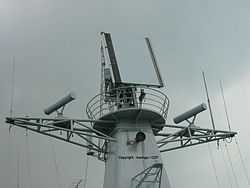Type 381 Radar
|
| |
| Country of origin | People's Republic of China |
|---|---|
| Introduced | unknown |
| Number built | unknown |
| Type | 3D Air Search |
| Frequency | C band |
| Range | 100 kilometres (62 mi) |
| Altitude | 8000 m |
| Diameter | unknown |
| Azimuth | unknown |
| Elevation | unknown |
| Precision | unknown |
| Power | 150 kW |
| Other Names | Sea Eagle, RICE SHIELD, RICE SCREEN |
The Type 381 was one of the first Chinese naval 3D search radar employing FRESCAN (Frequency Scanning) technique developed by the Nanjing Marine Radar Research Institute / No. 724 Institute. Initial versions were deployed on Jiangdong class FFG and Luda command variant class to provide long range surface search.
The original version Type 381 (Sea Eagle C) won the 1987 First Prize of the National Science and Technology Progression, and it is judged by western intelligence as the Chinese equivalent of American AN/SPS-39. Type 381 radar is able to simultaneously detect 50 targets and tracking 10 of the 50. A follow-on of Type 381 is Type 381Jia (甲), which can simultaneously detect 80 targets and track 20 of the 80.
An enhanced and upgraded version (Sea Eagle C-B) with dual band back to back canted antenna in similar fashion to the Russian 'TOP PLATE' radar have been introduced, with designation as Sea Eagle S/C(Type 382 Radar). These were installed on the Type 054A frigate as well as the Type 051B destroyer(Type 381), Type 051C(Type 382) class DDG.
Initially, many have confused the "Sea Eagle S/C"(Type 382) installed on newer Chinese warships with the Russian 'Top Plate' (MR-760) or it's copy, but with closer examination of the photos of both radar showed detailed differences, which link it to the "Type 381 radar" rather than the 'Top Plate' (MR-760).
Specifications
- Beam: 2.7° × 1.4°
- Peak power: 150 kW
- Pulse width: (original, 40), (Type A, 20), compressed to 1 microsecond
- PRF: (original, 370), (Type A, 730) average power of 2.2 kW
- Scan rate: 5 rpm
- Other features:
- Claimed able to track 10 targets simultaneously.
- Uses TWT+CFA coherent chain transmitter
- Reception is coherent with MTI improvement factor of 30 dBm
- Uses serpentine/waveguide
